Imagine you have just arrived at your testing site. You are eager; you are keen and you think you are ready. But although you may want to get straight to work, it is very important that you take some time to familiarise yourself with some key information. You must know how to spot the tell-tale signs of pollution if you are to achieve the most accurate results. So we recommend spending a few minutes reading this blog. That way, you will have all your gear and a good idea when you begin your water quality testing!
Oily Sheen
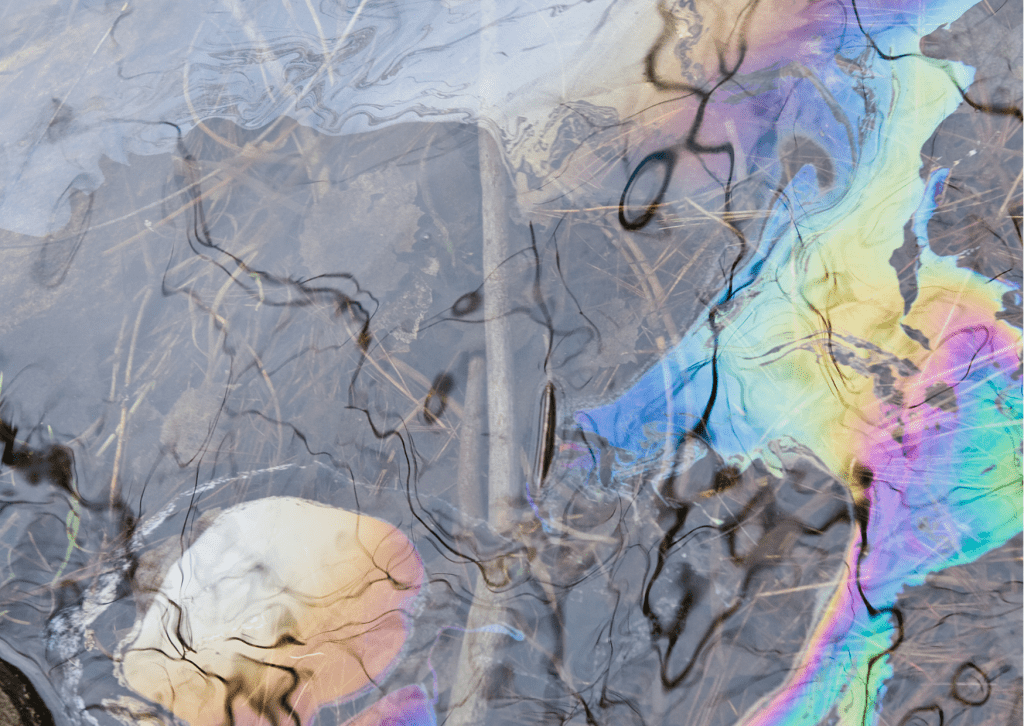
What causes oily sheens?
Oily sheens have both natural and unnatural causes. Regardless of the source of the sheen, it is important that it is recorded.
Petroleum, diesel and kerosene can all cause sheens when they are spilled and are the most common causes of unnatural sheens. Fuel leakages from boats is one source of oily sheens on waterways, but they can also stem from land-based machinery.
The two main natural causes of sheens on water are hydrogen sulphide and iron bacteria. Hydrogen sulphide is a naturally-occurring gas that is formed when organic matter, such as dead plants, animals or faeces break down underground. Alternatively, if water is contaminated with iron bacteria, it suggests an excess of iron-containing minerals. This can occur when a well is drilled in close proximity to a contaminated pond or lake.
What do I look for?
An oily sheen is characterised by an iridescent appearance on the surface of a waterbody. Look for unnatural rainbow shimmers, the kind you might see on the surface of a puddle on a road. Crude oil has a different appearance. It presents as a browny orange mass on the water’s surface.
If you suspect a natural sheen to be present, you should stir the water with a stick to establish its cause. If the film remains still when you stir, it’s probably hydrogen sulphide. If it breaks up into smaller pieces, it’s probably iron bacteria.
What does this mean?
Petrol and other fuels pose an immediate threat to the natural environment. Contaminating the water’s surface, they prevent oxygen from reaching the ecosystems below. Not only does this prevent aquatic plants from photosynthesising, but disrupts the entire food chain. It can take years for the environment to function normally again.
Boat fuel is particularly damaging to marine life. Sea birds consume fish from polluted waters or their feathers can become coated.
While neither hydrogen sulphide nor iron bacteria pose immediate health risks, they do cause a number of unpleasant side effects that most people would wish to avoid. As well as a smell of rotten eggs, they each can corrode plumbing and make black or yellow stains on water fixtures.
Foam
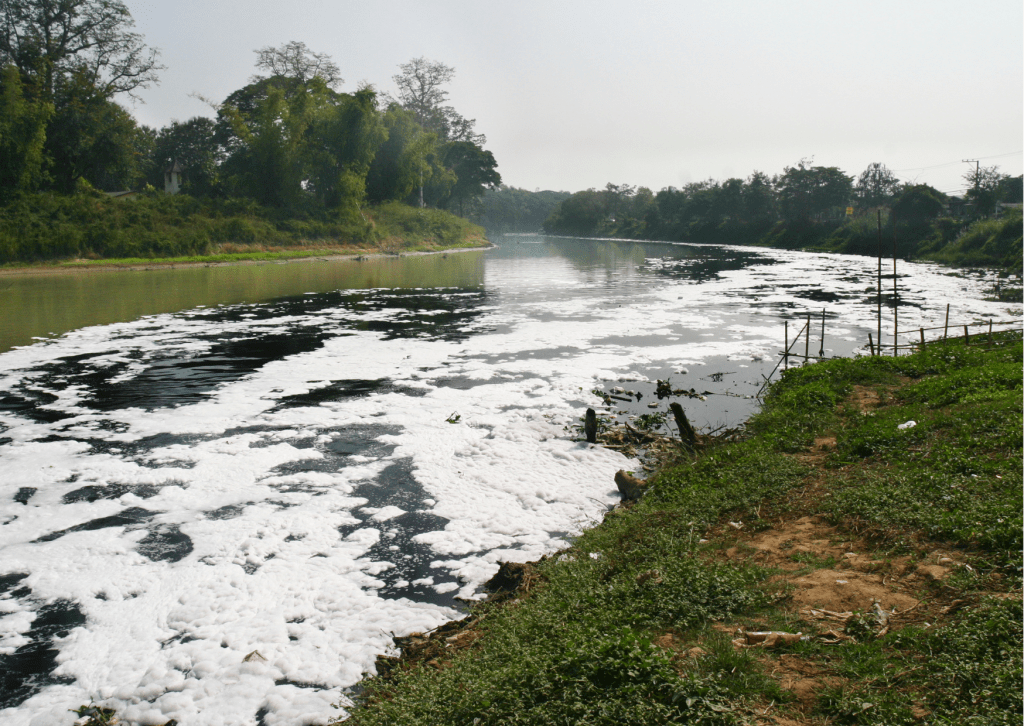
What causes foam?
Foam can be deceptive. Sometimes it is naturally occurring, made by air on water. However, it can also result from man-made detergents contaminating the water.
What do I look for?
The characteristics of foam vary depending on its source but overall it looks like a very thick washing up liquid floating on the water’s surface.
Natural foam is beige, pale brown or off white in colour1. It usually smells a little fishy or earthy and can cover large areas. A defining feature of natural foam is that it can blow away easily, usually gathering on shorelines where it is windy.
In contrast, man-made foam is harder to shift. White in colour, it often lingers in one, small area. Unlike natural foam, it can smell fragrant (if caused by detergent) or like decay (if caused by more toxic substances).
What does this mean?
Man-made foam harms aquatic life. It can cause fish to migrate away from an area or, in extreme cases, to die. For humans, foam is not as toxic, however swimming is not advisable if man-made foam is present.
Surface algae
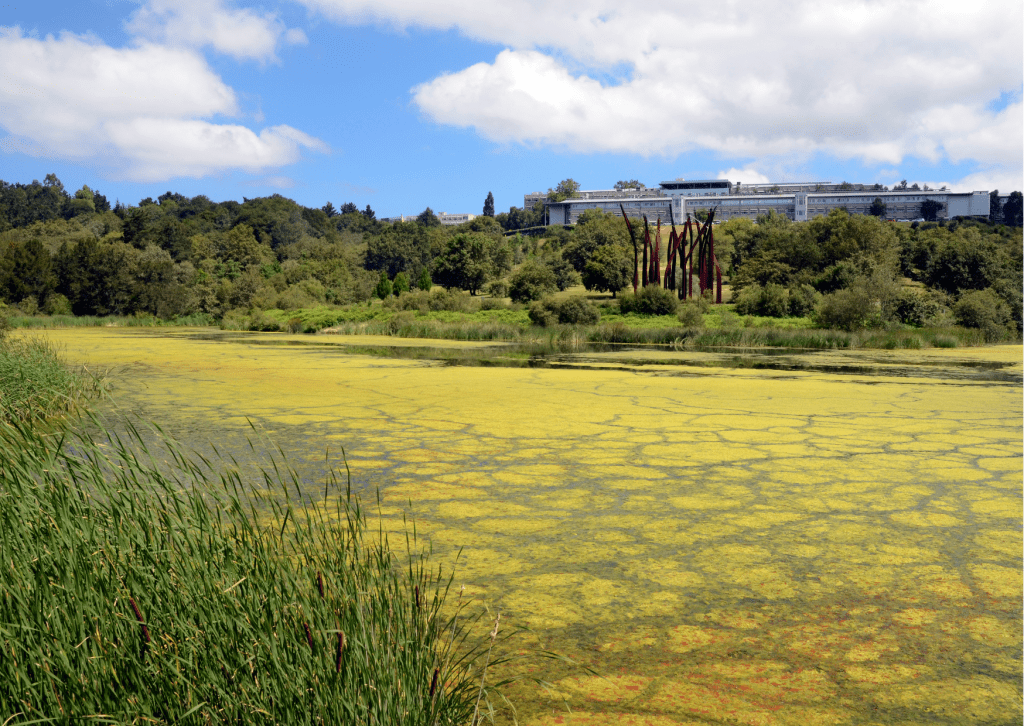
What causes surface algae?
Algae responds quickly to changes in water condition. As such, it is a very useful indicator of an ecosystem’s overall health. Surface algae is often caused when there is an abundance of nutrients in the water – for instance if phosphate-rich agricultural fertilisers wash into a waterbody.
What do I look for?
It is normal for there to be some algae in water bodies but when it occurs in large quantities it indicates that a waterway may be polluted. Green algae can give the appearance of a thick carpet covering the surface of the water when it has grown in abundance. Some algae can develop odours, described as spicy, fishy or grassy.
What does this mean?
Algae, in large quantities, can negatively impact waterways. It can prevent light from reaching the ecosystems living below the water’s surface and leave little oxygen for fish and other aquatic life.
The blue-green algae (in reality a bacteria if we are being picky) is particularly harmful. It can cause illness and irritation if it comes into contact with human skin and is especially bad for dogs. As such, they should not be allowed to swim in lakes with surface algae.
Sewage-related litter
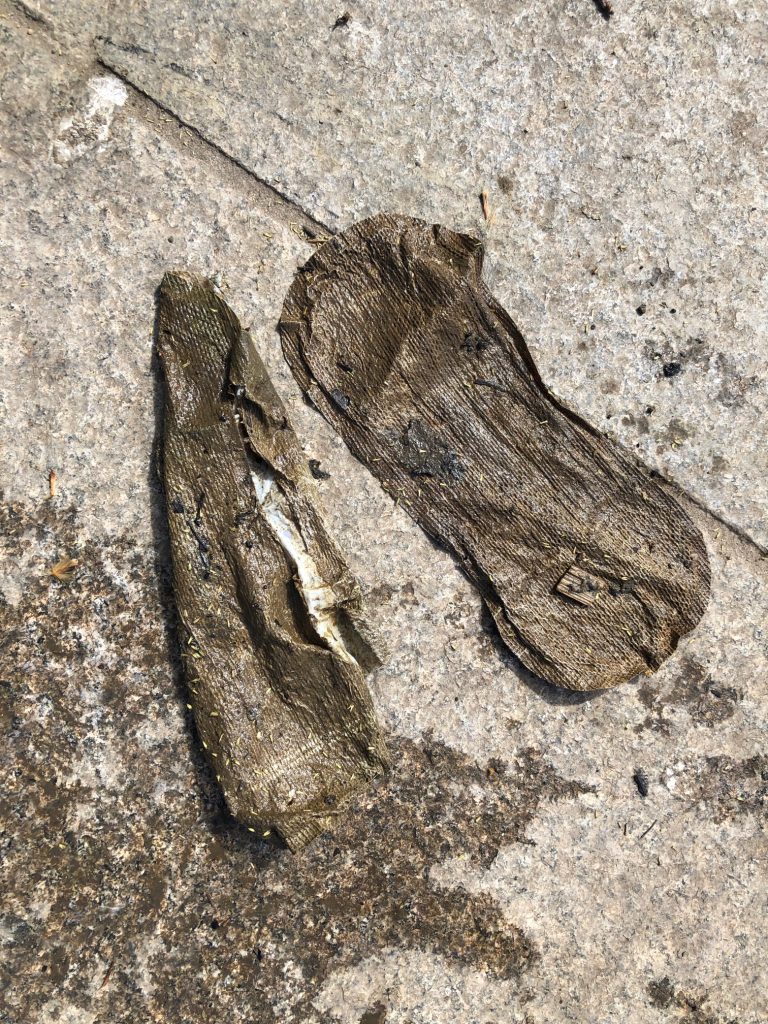
What causes sewage-related litter?
Sewage-related litter ends up in our waterways when sewage is discharged from storm water overflows. In the UK, it is legal for water companies to release raw sewage to prevent it from overflowing during periods of prolonged rainfall. Last year in England, water companies expelled raw sewage into rivers a total of 372,533 times. This means that untreated sewage flowed into our waterways for 2.7 million hours2.
On an individual level, we can make a difference to sewage-related litter if we correctly dispose of products. This means not flushing sanitary pads, tampon applicators or wet wipes down the toilet.
What do I look for?
Check for sanitary waste such as wet wipes, sanitary pads (both period and incontinence), tampons, tampon applicators and cotton buds. All these items are evidence of sewage discharge.
What does this mean?
Sanitary items often contain plastics, which pose serious risks to both aquatic and land-based wildlife. If ingested, plastics impact the growth, development, reproduction and the overall lifespan of these creatures. Additionally, sanitary items in waterways can combine with fats and oils, creating fatbergs that block and reduce the capacity of a sewer.
The plastics contained within sewage-related waste also break down into tiny pieces known as microplastic. Once present in an ecosystem, these pieces are nearly impossible to remove and do not biodegrade. As such, they can exist for 100s of years in water bodies. Studies do not exempt microplastics from having a negative impact on human health, but suggest that more research should be conducted in this area3.
Sewage fungus
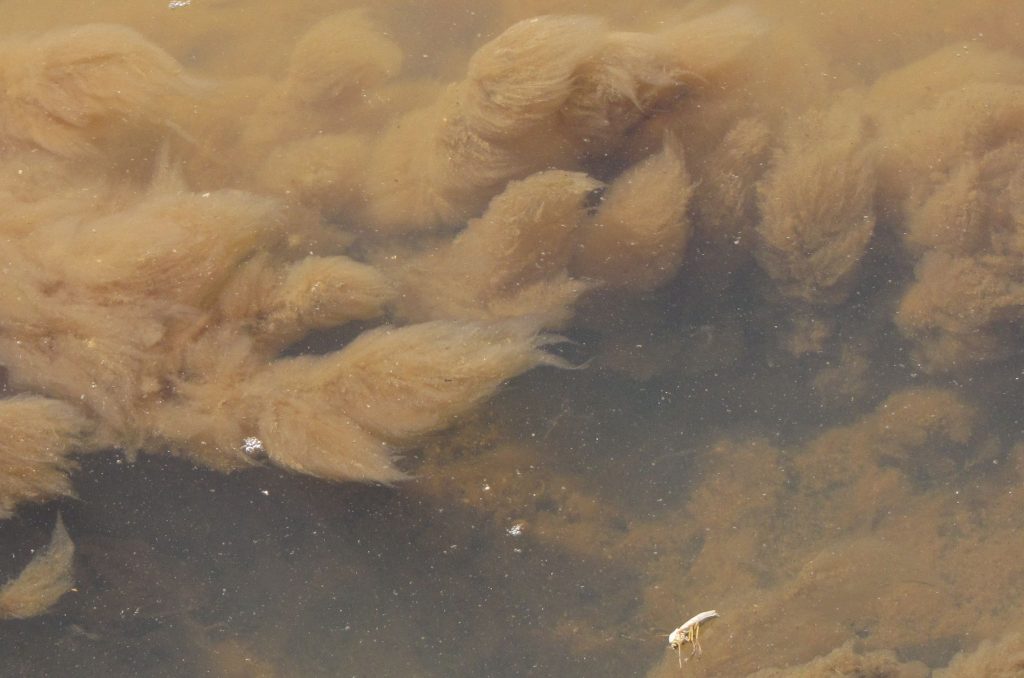
What causes sewage fungus?
Sewage fungus is usually a sign of serious pollution. It is caused by a mass of bacteria that builds up on almost any surface where there is a flow of water and the necessary nutrients. These bacteria are most frequently found where there are misconnections in the sewage system or in places where farm waste runs into the river.
What do I look for?
Sewage fungus is a thick growth of bacteria and fungi that develops in water contaminated with sewage.
What does this mean?
Sewage fungus can cause oxygen levels to drop drastically – sometimes to the point at which the water can no longer support aquatic life. As long as wastewater continues to be discharged into the waterway via the sewer, the water quality will not improve.
In slow-moving water, pollution tends to be more concentrated. If this is the case, sewage fungus will be thicker. However, if the sewage leakage stops, the fungus will disappear almost as quickly as it appeared.
Unpleasant or unusual odours
What causes unpleasant odours?
The cause of an unpleasant odour depends on the particular pong you detect. For instance, you might come across the smell of rotten eggs which would indicate a naturally-occurring interaction between bacteria, magnesium and aluminium.
Alternatively, you could encounter very fishy water. Sadly this does not mean that there is a thriving fish population! Conversely, it is linked to algal blooms or the presence of chemicals such as barium, cadmium, and chloramine. Far more logically, water that smells of sewage is usually linked to genuine sewage contamination.
What do I look for?
Perhaps a more appropriate heading would be: What do I sniff for? Be on the alert for the smell of rotten eggs, sharp smells, unnatural scents or the smell of gas. All these smells are common indicators of pollution.
What does this mean?
If you encounter a strange smell, it is recommended that you contact your local water company to report the pollution.
The smell of rotten eggs does not cause long-term damage to human health, although repeated exposure can contribute to feelings of nausea. However, in some cases, algae particles from blooms could seep into drinking water. If consumed in quantity, this can cause vomiting and nausea.
Litter pollution
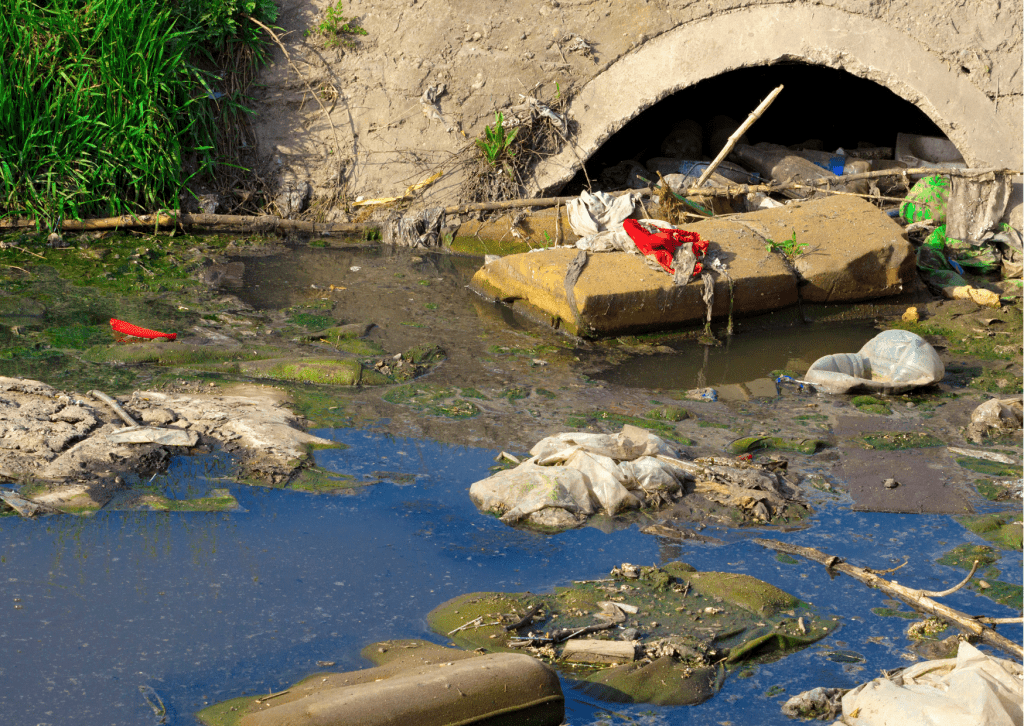
What causes litter pollution?
Rubbish bags of plastic litter easily overflow from landfill sites. Heavy rainfall then washes this pollution directly into waterways. Litter can also end up in lakes and rivers as a result of fly tipping or acts of littering by individuals.
What do I look for?
Be aware of general litter and any significant amounts of waste that’ve been dumped. Frequently fly tipped items include: large, hard-to-dispose of appliances, domestic items such as sofas, tyres and construction waste.
What does this mean?
No matter the origin, litter can create toxicity in water due to the harmful chemicals and hazardous materials it contains. The toxins found in the contaminated water can cause serious medical issues, or even kill, animals drinking from the supply. It could also kill plant life on riverbanks or below the water’s surface.
Aside from the toxins, physical plastic pollution can be hugely problematic. For one, animals can choke on or become entangled in litter items. It can also clog drainage systems, causing toxic floods that pollute the surrounding soil and water sources.
Orange or patchy water
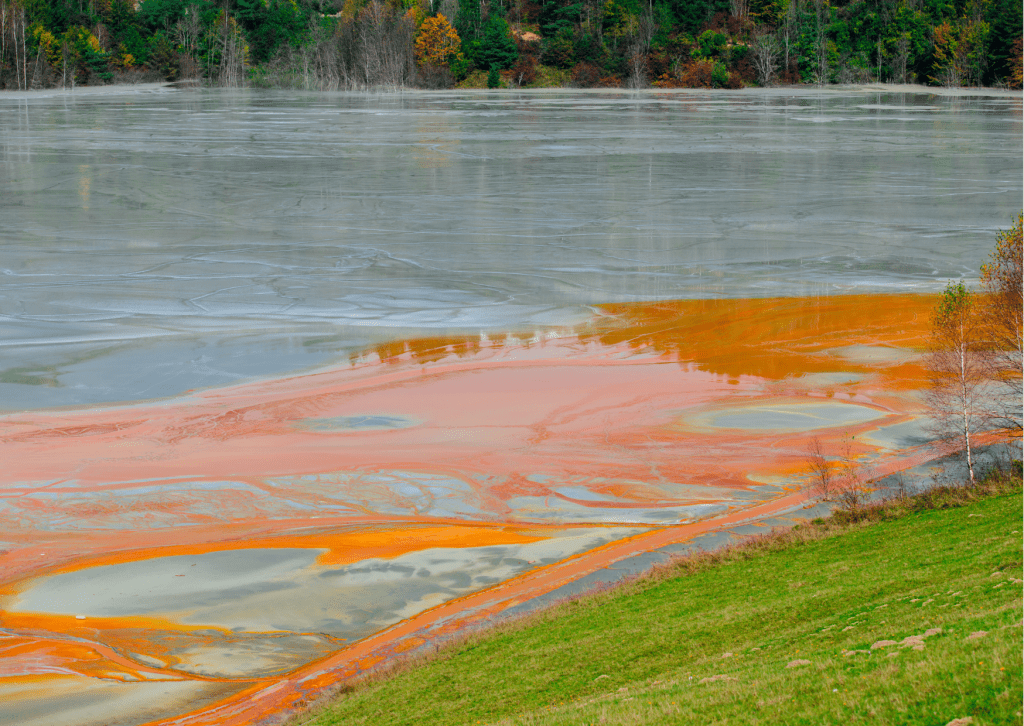
What causes orange or patchy water?
Although orange water could be an indicator of naturally occurring iron-oxide deposits, it could also be caused by pollution from a mine. If orange or patchy water suddenly occurs, it could suggest that there has been a change in the speed or direction of flow. Such changes can stem from changes in demand, for instance a rising use of hosepipes when the weather turns hotter.
What do I look for?
Check water samples to see if they appear brown or orange in colour. On occasion, brown or orange bits can be seen floating in water.
What does this mean?
Iron-oxide deposits are naturally-occurring minerals which settle in water mains over time. As a sediment, it normally settles to the bottom of the water pipes and isn’t harmful. However it can taste bitter, clog pipes and cause them to rust and decay over time.
Dead fish
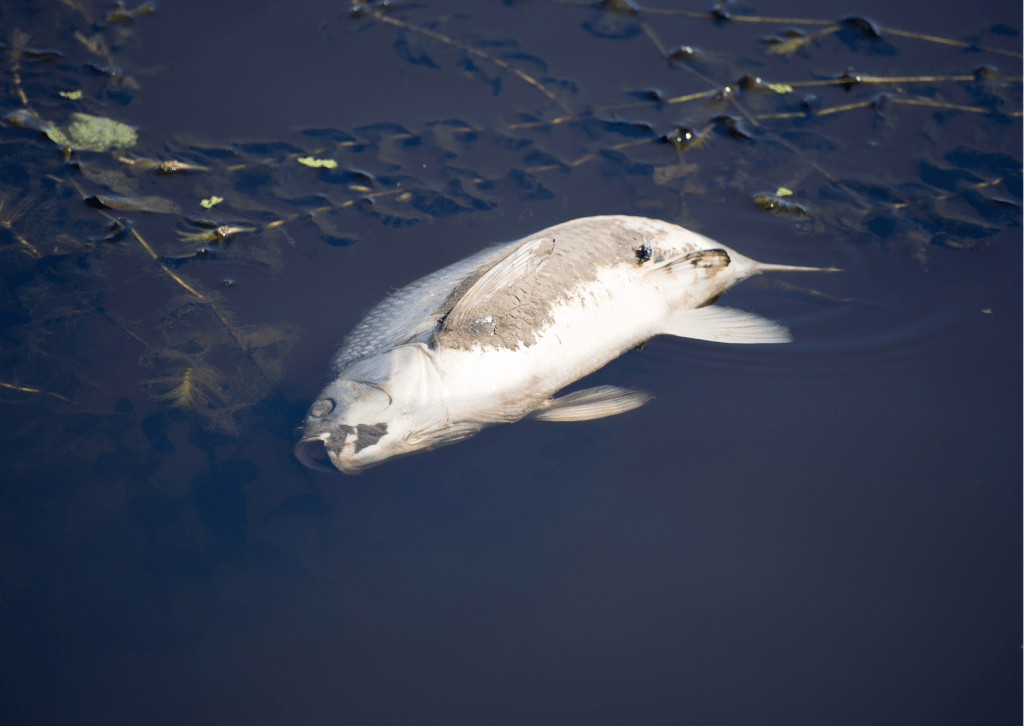
What causes fish to die?
Very often pollution generated from human activity is responsible for deaths in the fish population. This includes releases of toxic chemicals, pesticides, fertilisers, crude oil, used oil, sewage, and chlorinated water. When these pollutants are present in a waterway in high concentrations, they can cause fish to die either as a result of poisoning or lack of oxygen.
What do I look for?
If you notice multiple dead fish in a single waterway, it is a cause for concern.
What does this mean?
Dead fish are a clear sign that something is wrong in a waterway. However, it is hard to determine the reason if there are no other signs.
Dead animals
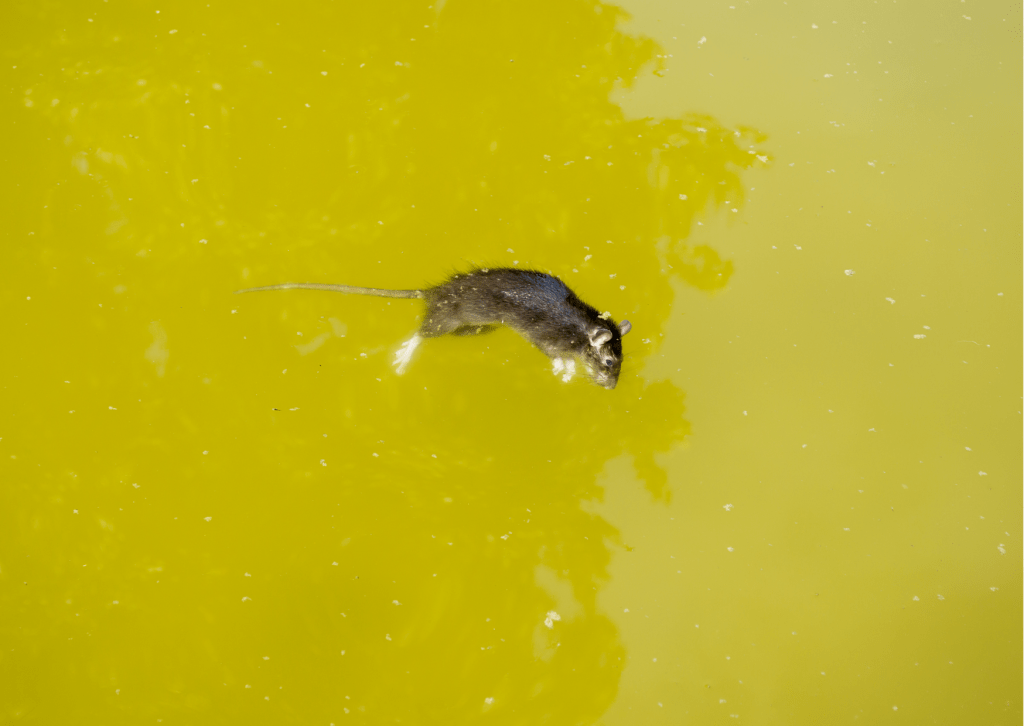
What causes animals to die?
Water contaminated with high concentrations of chemicals used in fertilisers (nitrates and phosphates) or with chemicals found in DDT can, at worst, kill birds and mammals.
What do I look for?
Watch for bodies of birds or small mammals either in the water or nearby.
What does this mean?
It is incredibly serious if pollution is strong enough to kill animals and if recorded, this information should be passed to your local environmental officers or water authority. These deaths are unnatural and can be upsetting to witness, but by reporting instances of death, you are helping to prevent future incidents.
Serious pollution is hugely consequential for biodiversity. First there are the deaths directly caused by consumption of toxins. But there are also indirect deaths linked to the diseases carried by carcasses in water. These can be passed on to other animals and human life if the water is ingested. These include:
- Anthrax: a bacterial disease that can still be contagious long after the animal’s death.
- Tularemia: another bacterial disease spread through spores.
- Parasites: mites, fleas and ticks living on the corpse can pass on diseases like lyme disease, typhus and scabies.
- Leptospirosis: also called Weil’s disease and carried through bodily fluids of infected animals, even through water.
1 https://www.rappflow.org/resources/faq.html
2 https://www.statista.com/statistics/1180077/water-company-sewage-discharges-england-rivers/
3 https://www.oaepublish.com/wecn/article/view/5035